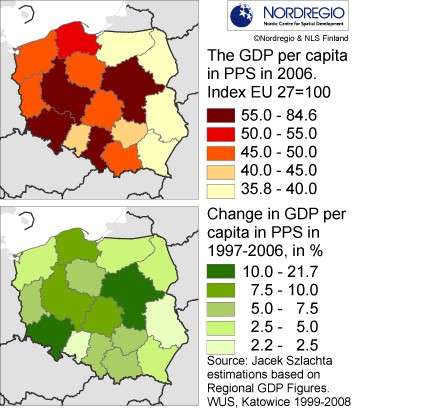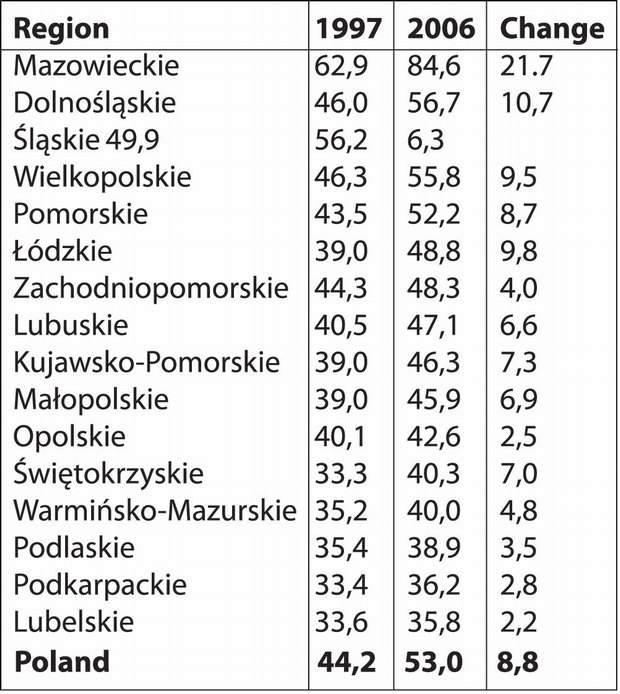Since 1 May 2004 the entire territory of Poland was granted Objective 1 status, which marks out the lagging behind areas in terms of socio-economic development. In the period 2004-2006 Poland received about 12.8 billion euro (fixed prices as of 2004) from the Structural and Cohesion Funds in the form of six operational programmes. One of these programmes was the Integrated Regional Development Operational Programme composed of sixteen regional segments implemented by the regional governments.
2007 brought significant programming modifications to the EU financial aid regime within the framework of the Cohesion Policy. In the new array of policy objectives the Convergence objective received an allocation of 81.5% of the Community funds. In addition, Poland became eligible for the European Territorial Cooperation objective.
The total earmarked transfers to the country resulting from the new Cohesion Policy in the years 2007-2013 total some 59.5 billion euro in fixed prices as of 2004 and 67.3 billion euro in current prices.
If complemented with two funds shifted to the sectoral policies, namely: the European Agricultural Fund for Rural Development and European Fisheries Fund, this allocation will grow by 13.2 billion euro and 0.7 billion euro respectively (in current prices). Such an amount denotes the largest EU assistance envelope in the history of the Community, as average annual transfers are equal to 4% of Poland's gross domestic product (GDP).
The Polish government took the decision to devolve implementation of the 2007-2013 Cohesion Policy. Regional govern-ments were entrusted sixteen regional operational programmes co-financed from the European Regional Development Fund. In addition, a majority of priorities and measures in the sectoral 'Human Capital' Operational Programme will also be implemented through a regionalised scheme.
Furthermore, responding to the burning structural problems in the eastern areas of the country, a dedicated operational programme was designed to serve the five poorest Polish regions.
The scheme, taken as a whole, oversees the most thorough-going attempt at devolution in the programming and implementation of the Structural Funds ever attempted in the European Union.
As an inheritance from the era of the centrally planned economy, Poland was left with old-fashioned and inefficient socio-economic structures but with relatively low regional disparity levels.
The trans-formation process towards the market economy, however, undoubtedly favoured the metropolitan regions as the centres of a multi-sectoral economy with well developed research, development and service facilities.
The period between 1997 and 2006 saw the economic convergence of the country boosted by 10 % measured in the GDP per capita - as compared with the EU average.
In the same period, both intra- and interregional disparities however became deeper. Warsaw's metropolitan region of Mazowsze (Masovia) recorded the fastest growth among EU NUTS 2 regions in this period with the GDP per capita index rising by 22%.
At the same time however the eastern Polish regions saw an increase of barely 2-4%. It is nevertheless important to bear in mind that all Polish regions have converged faster than the average EU trend.
The overall assessment of the current regional policy model in Poland provides that:
1. The policy reveals two particular dimensions: intra- and interregional, with a remarkable contribution of the Structural Funds to the shifting of focus in competences and resources towards intraregional policy;
2. It makes use of a quality-diversified set of strategic documents;
3. It is based on a somewhat thin legislative basis;
4. It is compliant with EU Cohesion Policy thus overseeing a transfer of modern knowhow in the areas of: programming, management, financing, monitoring, evaluation and project selection;
5. It has, to a lesser and lesser extent, a levelling character and instead addresses measures fostering the competitiveness of the regions;
6. It forms a solid component of national development policy, which promotes rigid domestic growth incentives;
7. It provides a rather complicated framework for operational actions by the regional governments.
This diagnosis exposes some key weaknesses in Poland's regional policy and points to the urgent need to tailor some of its essentials in a more appro-priate way. The most important pre-requisites in developing a better suited regional policy model from 2013 onwards stipulate that:
1. It is necessary to consider further solidification of the devolved policy model, as induced by the Structural Funds;
2. It is recommended that the relationship between state government representation in the region and the regional government is clearly defined. The current arrangement often produces competence conflicts, undesirable overlapping and duplication of effort, as well as the intrusion of politics into the decision-making processes;
3. It is necessary to define the feasibility of setting the regional policy in the context of territorial scales such as: macro-regions, metropolitan areas, sub-regions and territories of shared development challenges. The solutions devised thus far do not facilitate collaboration between the involved regional governments while actually hampering policy-response actions;
4. It is necessary to broaden the spectrum of available regional policy instruments. This postulate applies in particular to the establishment of various development support funds and agencies as well as to the triggering of cooperation networks, partnerships and development pacts;
5. It is necessary to eliminate incons-istencies in the shaping of individual regional policy segments with regard to the model as a whole as well as with the instruments and the coordination of the development processes;
6. It is necessary to further develop a research base for the result-oriented evaluation of regional policy and thus for the calibration of its model. For this purpose both macroeconomic modelling at the national and regional levels and the upgrading of evaluation to become a public policy assessment tool ought to be considered;
7. The identified weaknesses in the legal foundations of regional policy in Poland need to be remedied through the recon-struction of the policy's institutional system. The content-related, financial and organi-
sational dimension of necessary actions determine the complexity of this task;
8. It is necessary to define an optimum model for Poland's regional policy in the post-aid period, that is to say, when the country is no longer a beneficiary of the EU Cohesion Policy in its current form.
Discourse about the future regional policy model in Poland may be easier if clear expectations are voiced with regard to legislative and institutional solutions.
While a complete list of such expectations is not feasible at this stage, some postulates refer to an opportunity to explore the potential of the Polish regions for: stimulation of the socio-economic development of the country, setting a multi-year time horizon for pro-gramming and financing of regional development measures, devolution of the public finances system through a transfer of more resources from the state to the regional budgets, enhancing a civil society designed to encourage and produce a more professional and a less politically-saturated regional policy-making approach.
The modernisation of the Polish regional policy system undoubtedly then remains one of the most significant national challenges in the economic and public administration fields in the coming years.
By Jacek Szlachta, Profesor Warsaw School of Economics
Regional differences
Table 1 The gross national product per capita by purchasing power parity in Polish NUTS 2 regions in 1997-2006 (UE 27=100)


Source: Own estimations based on: Produkt Krajowy Brutto. Rachunki Regionalne (Gross Domestic Product. Regional Figures), WUS, Katowice 1999-2008.